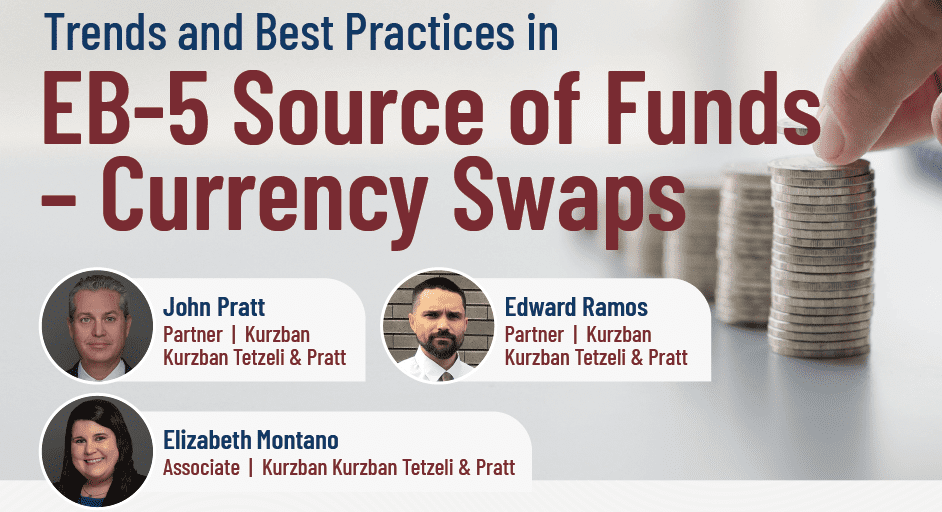By: John Pratt, Partner; Edward Ramos, Partner; Elizabeth Montano, Attorney | Kurzban Kurzban Tetzeli & Pratt

This is a sneak preview of the Spring 2023 edition of IIUSA’s Regional Center Business Journal (RCBJ). The full edition will be available in print at IIUSA’s 13th Annual EB-5 Industry Forum later this month in San Diego and in digital format around the same time. Stay tuned for more articles coming soon.
Once a backwater in EB-5 adjudications, “source of funds” issues have become ever-more common in recent years as U.S. Citizenship & Immigration Services (USCIS) has significantly expanded the scope of its inquiry. From shifts in the way USCIS adjudicates cases on “currency swaps,” to USCIS’s increasing demands for a near impossible level of evidence, to scrutiny of source of funds issues at the I-829 stage, to USCIS’s examination of the source of funds of non-EB-5 investors in projects, the source of funds landscape has become a minefield.
In this article, we focus on the first major trend: the way USCIS adjudicates the lawful source of funds requirement as it relates to cases involving “currency swaps”—a common method for EB-5 investors to exchange and transfer currency. The article describes the areas USCIS focuses on in such cases, outlines the current state of litigation challenging some aspects of these trends, and provides practice pointers for stakeholders to avoid source of funds related denials in cases involving currency swaps.
Background on Source of Funds Requirement
The requirement that investor funds derive from lawful sources has been a part of the EB-5 Program since the first regulations implementing the program were promulgated in 1991. The requirement is embodied in two regulations: (1) the regulation defining “capital,” which says that assets do not qualify as “capital” for EB-5 purposes if they were “acquired, directly or indirectly, by unlawful means (such as criminal activities);”[1] and (2) the regulation explaining the evidence EB-5 investors must present to show that they have “invested, or [are] actively in the process of investing, capital obtained through lawful means.”[2]
In 1998, the Immigration and Naturalization Service—USCIS’s predecessor agency—published four precedential EB-5 decisions.[3] Three of the four cases applied the source-of-funds requirement to deny the investor petitions. In Matter of Izummi, the agency found that the applicant failed to show the lawful source of his investment funds where the applicant “failed to document the source of the hundreds of thousands of dollars in his bank accounts,” what his “level of income” was, or even “where the[] funds originated.”[4] Similarly, in Matter of Soffici, the applicant claimed to have acquired money through the sale of a house and business, but provided “[n]o documentation, such as a sales contract or deed establishing [their] ownership and price” of either the house or the business.[5] And in Matter of Ho, the agency held that the investor failed to show a lawful source of funds where the “the wire-transfer receipt” for the EB‑5 investment did not show “from what bank account(s) the funds originated,” there was no evidence that the investor or his spouse actually sold any of their assets to make an EB-5 investment, and the investor submitted no evidence to establish that he actually “engaged in [his claimed] occupation” or “his level of income.”[6]
Each of these decisions represents a fairly straightforward failure on the part of the investor to document the origins and path of their EB-5 investment. For many years, USCIS decisions largely tracked this precedent, denying I-526 petitions only in cases where the investor’s failure to document the origins and path of their EB-5 investment was straightforward—i.e., where the record contained significant inconsistencies in the source of an investors’ funds or where the record contained major evidentiary gaps like those in the precedent decisions.
But this is no longer the reality. Over the past approximately five years, USCIS has made dramatic, expansive changes to its internal policies and procedures regarding source of funds adjudications in various respects, both at the I-526 and the I-829 stages. One major area where it has done so is in cases involving “currency swaps.”
[1] 8 C.F.R. § 204.6(e)
[2] 8 C.F.R. § 204.6(j)(3)
[3] Matter of Izummi, 22 I. & N. Dec. 169 (Assoc. Comm’r 1998); Matter of Soffici, 22 I. & N. Dec. 158 (Assoc. Comm’r 1998); Matter of Ho, 22 I. & N. Dec. 206 (Assoc. Comm’r 1998); Matter of Hsiung, 22 I. & N. Dec. 201 (Assoc. Comm’r 1998).
[4] Matter of Izummi, 22 I. & N. Dec. at 195.
[5] Matter of Soffici, 22 I. & N. Dec. at 164–65.
[6] Matter of Ho, 22 I. & N. Dec. at 211.







